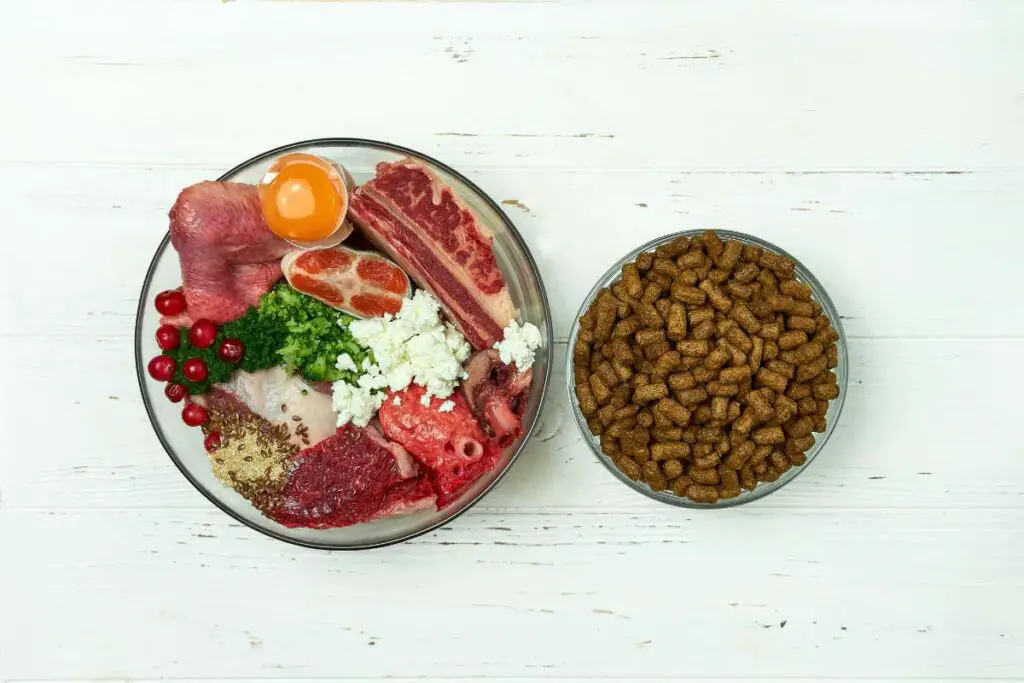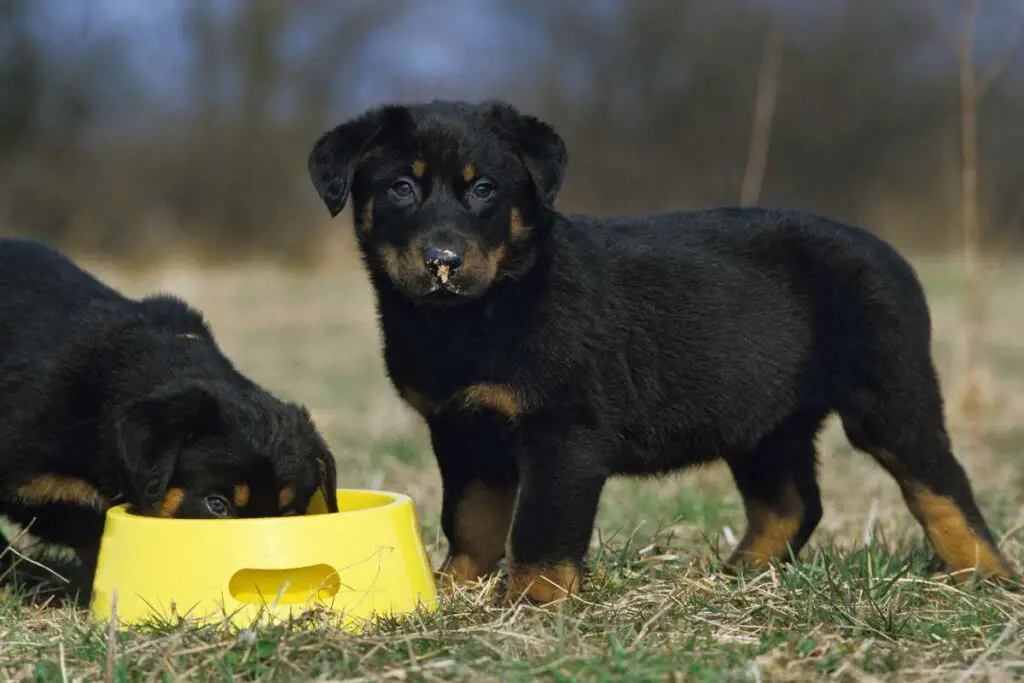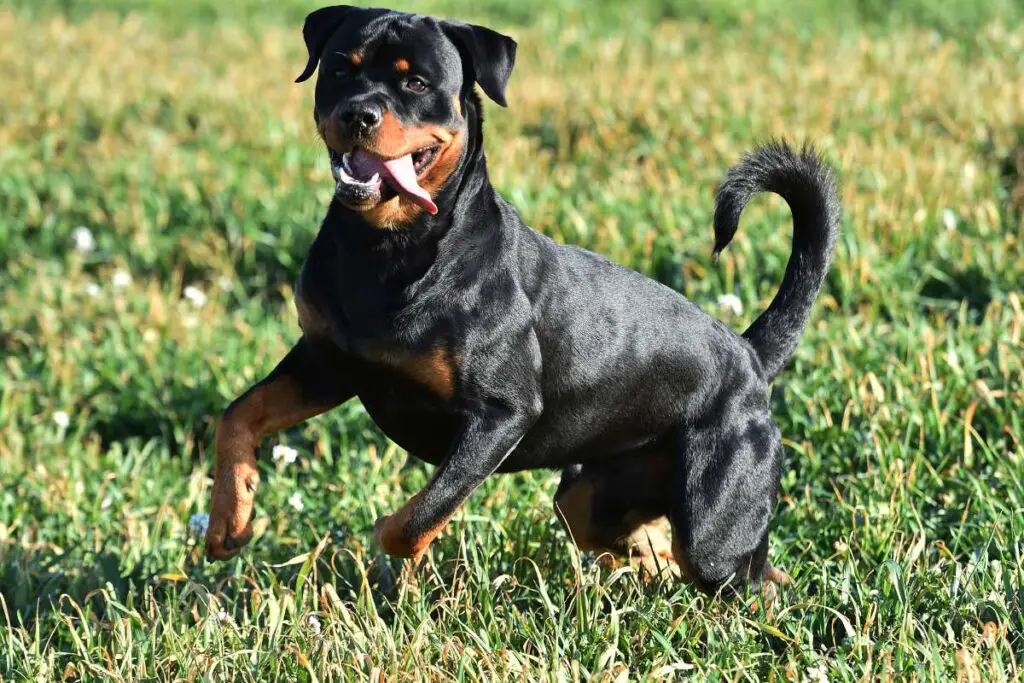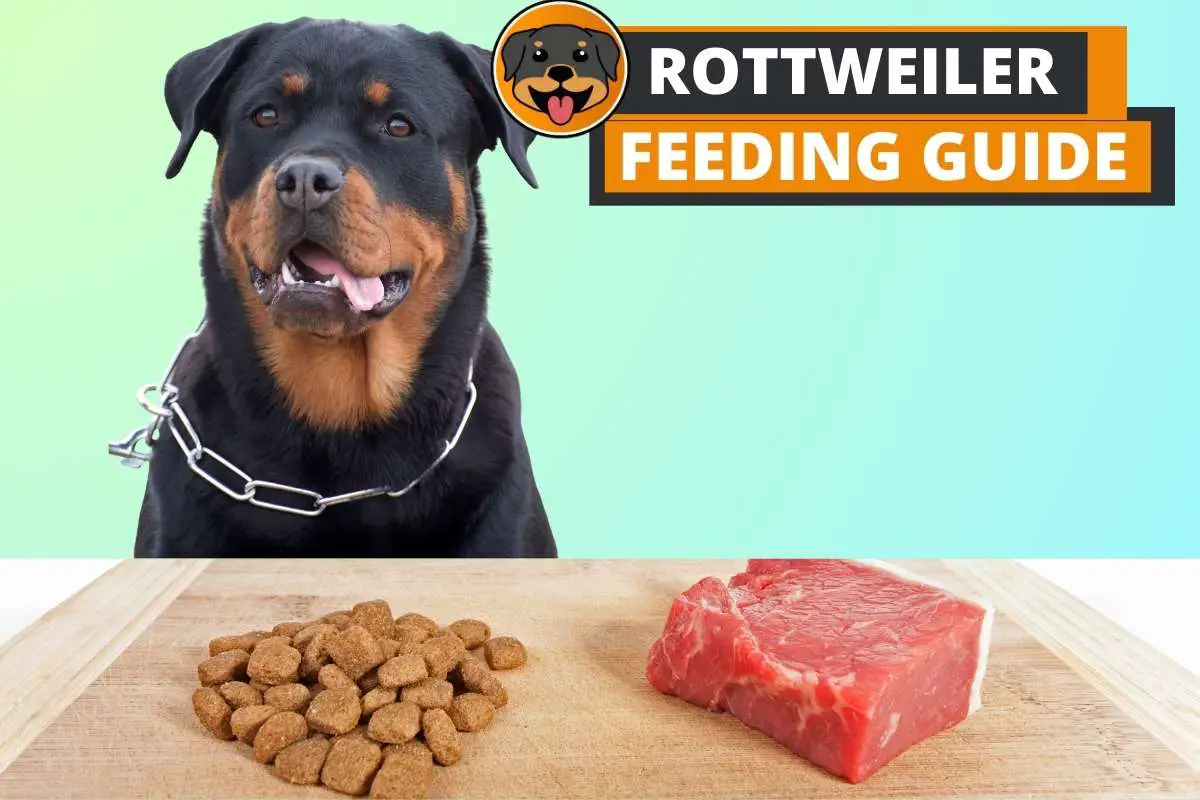Have you ever wondered if you’re feeding your Rottweiler the right way? Are you worried about providing the best possible diet to keep your furry friend healthy, happy, and strong? Well, you’ve come to the right place!
In today’s article we will cover everything you need to know about feeding your rottweiler, be it puppy, adult or senior.
What Do You Want in Your Rottweiler’s Food

When it comes to your Rottweiler’s food, it’s super important to make sure it’s high-quality and nutritious to keep them strong and healthy. So, here are some key things you should look for in your Rottweiler’s food:
- High-quality proteins: Protein is the main building block for your Rottweiler’s muscles and overall health. You’ll want to choose foods with high-quality protein sources like chicken, beef, fish, or turkey. These should be listed as the first ingredient in the dog food.
- Healthy fats: Fats are essential for your Rottweiler’s skin, coat, and overall well-being. Look for dog foods that contain healthy fats like omega-3 and omega-6 fatty acids from sources like fish oil or flaxseed.
- Carbohydrates: Complex carbs are great for providing your Rottweiler with the energy they need for their daily activities. Look for dog foods that contain whole grains, sweet potatoes, or peas as sources of carbohydrates.
- Essential vitamins and minerals: Your Rottweiler needs the right balance of vitamins and minerals for optimal health. Make sure the dog food you choose has a well-rounded mix of essential nutrients like calcium, phosphorus, vitamin A, vitamin D, and vitamin E.
- Fiber: Fiber is important for your Rottweiler’s digestive health. Look for dog foods that contain a good amount of fiber from sources like beet pulp or pumpkin.
- No artificial additives: Avoid dog foods that contain artificial colors, flavors, or preservatives, as these can cause allergies and other health issues.
- Size-specific formula: Look for dog food that is formulated specifically for large breeds, as they have different nutritional needs compared to smaller breeds. Some brands even have Rottweiler-specific formulas that cater to their unique needs.
Generally, a Rottweiler’s diet should maintain the following ratio of nutrients:
| Food | Portion/meal |
|---|---|
| Protein | 30% to 40% |
| Healthy Fats | 15% to 20% |
| Carbs | 30% to 50% |
Remember, every dog is different, so it’s always a good idea to talk to your vet about the best food for your specific Rottweiler.
Choosing the Right Food for Your Rottweiler

Picking the perfect food for your Rottweiler is super important for their health and well-being. You’ve got two main options: home-cooked meals or manufactured dog food.
Let’s talk about both and help you decide which one is right for your furry friend!
Home-Cooked Meals
- Customization: One of the biggest perks of home-cooked meals is that you can tailor them to your Rottweiler’s specific needs, preferences, and any dietary restrictions.
- Quality control: When you prepare your dog’s meals at home, you have complete control over the ingredients, ensuring they’re fresh and high-quality.
- Bonding: Cooking for your Rottweiler can be a fun way to bond with them and show them some extra love.
But there are some challenges too:
- Time-consuming: Preparing home-cooked meals every day can be time-consuming and may not be practical for everyone.
- Nutritional balance: It can be difficult to create a nutritionally balanced meal for your Rottweiler without the guidance of a veterinarian or pet nutritionist.
A healthy and well-balanced meal of your Rottweiler should look like this:
| Food | Portion per meal | Source |
|---|---|---|
| Meat/fish | 60% | White Chicken Meat, liver, mackerel, tuna, kidney beans, etc. |
| Vegetables | 10% | Baby carrots, beets, spinach, sweet peas, spinach, green beans, etc. |
| Carbs | 20% | Oatmeal, plain rice, potatoes, sweet potatoes, plain pasta, etc. |
| Fruits | 5% | Raspberries, strawberries, banana, mango, pear, etc. |
| Extras | 5% | Cottage cheese, plain yogurt, eggs. |
Manufactured Dog Food
- Convenience: Manufactured dog food is super easy to serve – just open the bag and pour it into your dog’s bowl.
- Balanced nutrition: High-quality dog food is formulated to provide all the essential nutrients your Rottweiler needs.
- Variety: There’s a wide variety of dog food options available, making it easier to find one that suits your Rottweiler’s specific needs.
But keep these things in mind:
- Quality: Not all manufactured dog foods are created equal. Look for high-quality brands with natural ingredients and avoid those with artificial additives.
- Cost: High-quality dog food can be pricey, but it’s worth it for your Rottweiler’s health.
Here are some of the best puppy food for rottweiler puppies.
So, which one should you choose?
It really depends on your lifestyle and preferences. If you have the time and dedication to prepare home-cooked meals, it can be a rewarding option.
Just make sure to consult with your vet or a pet nutritionist to ensure your Rottweiler gets all the nutrients they need.
If you prefer the convenience of manufactured dog food, go for a high-quality brand that’s specially formulated for large breeds or Rottweilers. Read the labels, check the ingredients, and talk to your vet for recommendations.
How to Feed Your Rottweiler?

When it comes to feeding your Rottweiler, there are two main methods: free feeding and scheduled feeding. Let’s dive into both options and figure out the best way to feed your beloved furry friend.
Free Feeding
Free feeding is when you leave food out for your Rottweiler all day, allowing them to eat whenever they want. While it might seem convenient, free feeding isn’t ideal for Rottweilers for a few reasons:
- Overeating: Rottweilers are prone to overeating, which can lead to obesity and other health issues.
- Bloat: Rottweilers are at risk for bloat, a life-threatening condition that can occur when they eat too fast or too much. Free feeding increases the chances of bloat.
- Food freshness: Leaving food out all day can cause it to become stale or spoil, which isn’t good for your dog’s health.
Scheduled Feeding
Scheduled feeding means offering your Rottweiler meals at specific times during the day. This is the preferred method for Rottweilers, and here’s why:
- Portion control: With scheduled feeding, you can easily control how much your Rottweiler eats, helping to prevent overeating and obesity.
- Routine: Rottweilers thrive on routine, and scheduled feeding helps establish a consistent daily schedule for them.
- Bloat prevention: Feeding smaller meals at set times can help reduce the risk of bloat.
To establish a scheduled feeding routine for your Rottweiler, follow these steps:
- Choose meal times: Pick two or three times during the day when you’ll feed your Rottweiler. Ideally, these should be evenly spaced out, for example, morning and evening, or morning, afternoon, and evening.
- Measure portions: Based on your vet’s recommendations and the feeding guidelines on the dog food package, measure out the appropriate portion size for your Rottweiler’s age, weight, and activity level.
- Stick to the schedule: Consistency is key. Try to feed your Rottweiler at the same times every day to establish a routine.
- Monitor your dog: Keep an eye on your Rottweiler’s weight and overall health, and adjust their portion sizes or feeding times as needed. Consult your vet if you’re unsure about any changes.
Which is Better?
In conclusion, scheduled feeding is the best method for Rottweilers. It helps maintain their overall health, prevents overeating and bloat, and establishes a consistent routine that your furry friend will love.
How Much to Feed Your Rottweiler

Figuring out the right amount of food for your Rottweiler is crucial for their health and well-being.
However, it’s not a one-size-fits-all answer, as the amount of food your Rottweiler needs depends on several factors, including their age, weight, activity level, and overall health.
Here are some guidelines to help you determine how much to feed your Rottweiler:
- Read the dog food label: Start by checking the feeding guidelines on the dog food package. These guidelines are based on your dog’s weight and provide a good starting point for determining how much to feed them.
- Consider their age: Puppies, adults, and senior Rottweilers have different nutritional needs, so it’s essential to adjust their food intake based on their life stage. Puppies generally need more frequent, smaller meals, while adults can eat larger, less frequent meals. Senior dogs may require fewer calories as their activity levels decrease.
- Factor in their activity level: A highly active Rottweiler will need more calories to fuel their energy needs, while a more sedentary dog will need fewer calories to prevent weight gain. Adjust the portion sizes based on your Rottweiler’s daily exercise routine.
- Keep an eye on their weight: Regularly monitor your Rottweiler’s weight to ensure they’re not gaining or losing too much. If you notice any significant changes, consult your vet and adjust their food intake accordingly.
- Consult your vet: Your veterinarian knows your Rottweiler best and can provide personalized recommendations on the appropriate amount of food for your specific dog. Always consult your vet if you’re unsure about portion sizes or if you notice any changes in your dog’s eating habits or weight.
As a rough estimate, an adult Rottweiler usually needs about 1800 to 2400 calories per day. This calorie range can be divided into two or three meals throughout the day.
Remember, this is just a starting point, and it’s important to tailor your Rottweiler’s food intake to their individual needs.
How Often to Feed Your Rottweiler in a Day?

The frequency at which you feed your Rottweiler plays a crucial role in their overall health and well-being.
As mentioned earlier, scheduled feeding is the best approach for Rottweilers, as it helps prevent overeating and reduces the risk of bloat.
Here’s a breakdown of how often you should feed your Rottweiler based on their life stage:
- Rottweiler Puppies (up to 1 year old): Puppies have smaller stomachs and higher energy needs, so they require more frequent meals. Feed your Rottweiler puppy 3 to 4 times a day. As they grow and approach their first birthday, you can gradually reduce the frequency to 2 to 3 meals per day.
- Adult Rottweilers (1 to 7 years old): Adult Rottweilers typically do well with 2 to 3 meals a day. Feeding them at consistent times every day helps establish a routine and prevents them from getting too hungry between meals, which could lead to overeating.
- Senior Rottweilers (7+ years old): As your Rottweiler enters their senior years, their activity levels may decrease, and they might require fewer calories. In some cases, you can continue feeding them 2 to 3 meals a day, but with smaller portion sizes. However, it’s always best to consult with your vet to determine the optimal feeding frequency and portion sizes for your senior Rottweiler.
Keep in mind that the frequency of feeding can also depend on your dog’s individual needs and preferences.
Some Rottweilers might prefer smaller, more frequent meals, while others may do well with just two meals a day. It’s essential to monitor your Rottweiler’s weight, appetite, and overall health and make adjustments as needed.
Rottweiler Feeding Chart

A Rottweiler feeding chart can be a helpful guide for determining how much food your Rottweiler needs based on their age, weight, and activity level.
However, remember that every dog is unique, so it’s essential to monitor your Rottweiler’s weight and overall health, making adjustments as needed. Always consult your vet for personalized recommendations.
Here’s a general feeding chart for Rottweilers:
Rottweiler Puppies (up to 1 year old):
- 2 to 4 months old: 3 to 4 meals per day, around 1 to 1.5 cups of food per meal
- 4 to 6 months old: 3 meals per day, around 2 to 2.5 cups of food per meal
- 6 to 12 months old: 2 to 3 meals per day, around 2.5 to 3 cups of food per meal
Adult Rottweilers (1 to 7 years old):
- 70 to 90 lbs: 2 to 3 meals per day, around 4 to 4.5 cups of food per day
- 90 to 110 lbs: 2 to 3 meals per day, around 4.5 to 5.5 cups of food per day
- 110 to 130 lbs: 2 to 3 meals per day, around 5.5 to 6.5 cups of food per day
Senior Rottweilers (7+ years old):
- Senior Rottweilers may require fewer calories, so it’s important to monitor their weight and adjust their food intake accordingly. Consult with your vet to determine the appropriate feeding amount for your senior Rottweiler.
Remember that these are just general guidelines, and the actual amount of food your Rottweiler needs can vary based on their individual factors like metabolism, activity level, and overall health.
Always choose a high-quality dog food formulated for large breeds or Rottweilers specifically, and consult your vet for personalized advice on feeding your furry friend.
Feeding Rottweiler Puppies

Feeding Rottweiler puppies requires special attention, as they grow rapidly and have specific nutritional needs during their first year of life.
Here’s what you need to know about feeding Rottweiler puppies:
Choose the right food
Opt for a high-quality puppy food that’s specifically formulated for large breeds.
These foods are designed to support your Rottweiler puppy’s growth and development, providing the right balance of nutrients like protein, fat, and essential vitamins and minerals.
Portion sizes
Rottweiler puppies have smaller stomachs and higher energy needs, so they require smaller, more frequent meals.
Start by following the feeding guidelines on the puppy food package, adjusting the portions based on your puppy’s age, weight, and activity level.
Feeding frequency
- 2 to 4 months old: 3 to 4 meals per day
- 4 to 6 months old: 3 meals per day
- 6 to 12 months old: 2 to 3 meals per day
Monitor growth
Regularly weigh your Rottweiler puppy and track their growth to ensure they’re developing at a healthy rate. If you notice any sudden weight gain or loss, consult your vet for guidance.
Transition to adult food
As your Rottweiler puppy approaches their first birthday, you’ll need to gradually transition them to adult dog food.
Start by mixing a small amount of adult food into their puppy food, gradually increasing the adult food portion over a period of 7 to 10 days.
Avoid overfeeding
Overfeeding your Rottweiler puppy can lead to rapid growth, obesity, and joint issues. Make sure you’re providing the right portion sizes and not giving them too many treats or table scraps.
Consult your vet
Your veterinarian is your best resource when it comes to feeding your Rottweiler puppy. Schedule regular check-ups and follow your vet’s recommendations for feeding and growth.
Feeding Adult Rottweilers (1 to 7 years old)

Feeding adult Rottweilers requires a balanced approach to ensure they receive the proper nutrients to maintain their health and support their activity levels.
Here are some tips for feeding adult Rottweilers aged 1 to 7 years old:
Choose the right food
Opt for a high-quality dog food that’s specifically formulated for large breeds or Rottweilers. These foods will provide the right balance of nutrients like protein, fat, and essential vitamins and minerals to support your Rottweiler’s health.
Portion sizes
Determine the appropriate portion sizes for your Rottweiler based on their weight, age, and activity level.
Check the feeding guidelines on the dog food package as a starting point and consult your vet for personalized recommendations.
Feeding frequency
Adult Rottweilers typically do well with 2 to 3 meals a day. Feeding them at consistent times every day helps establish a routine and prevents them from getting too hungry between meals.
Monitor weight
Keep an eye on your Rottweiler’s weight to ensure they maintain a healthy weight. If you notice any significant changes, consult your vet and adjust their food intake accordingly.
Adjust for activity levels
A highly active Rottweiler will need more calories to fuel their energy needs, while a more sedentary dog will need fewer calories to prevent weight gain.
Adjust your Rottweiler’s portion sizes based on their daily exercise routine.
Limit treats and table scraps
Treats and table scraps can contribute to weight gain and health issues if given in excess.
Keep treats to a minimum and avoid feeding your Rottweiler human food that could be harmful to them.
Regular vet check-ups
Schedule regular veterinary check-ups to monitor your Rottweiler’s overall health and discuss any concerns about their diet or weight.
By providing your adult Rottweiler with a balanced diet and monitoring their weight and activity levels, you’ll help ensure they stay healthy and happy throughout their prime years.
Feeding Senior Rottweiler (7+ years)

As your Rottweiler enters their senior years, their nutritional needs and activity levels may change. It’s essential to adjust their diet accordingly to maintain their health and well-being. Here are some tips for feeding senior Rottweilers aged 7 years and older:
Choose the right food
Opt for a high-quality senior dog food that’s specifically formulated for large breeds or Rottweilers. Senior dog foods typically have a lower calorie content and the right balance of nutrients to support aging joints, maintain muscle mass, and promote overall health.
Portion sizes
Monitor your senior Rottweiler’s weight and adjust their portion sizes accordingly. Since their activity levels may decrease as they age, they may require fewer calories to prevent weight gain.
Feeding frequency
Continue to feed your senior Rottweiler 2 to 3 meals a day, but consider adjusting the portion sizes to meet their changing nutritional needs. Consistency is still crucial, so stick to a regular feeding schedule.
Monitor weight and overall health
Keep a close eye on your senior Rottweiler’s weight and overall health, making any necessary adjustments to their diet based on your observations and your vet’s recommendations.
Adjust for activity levels
If your senior Rottweiler remains active, they may still require more calories to maintain their energy levels.
On the other hand, if their activity levels decrease, you’ll need to adjust their food intake accordingly to prevent weight gain.
Supplements
Talk to your vet about whether your senior Rottweiler could benefit from supplements to support their joint health, digestion, or other age-related issues.
Regular vet check-ups
Senior Rottweilers may require more frequent veterinary check-ups to monitor their overall health and address any age-related concerns. Discuss your Rottweiler’s diet and any changes in their health with your vet during these check-ups.
By providing your senior Rottweiler with a balanced diet tailored to their changing needs, monitoring their weight and overall health, and working closely with your vet, you can help ensure they enjoy a happy and healthy life in their golden years.
Feeding Guide for Overweight Rottweiler

An overweight Rottweiler is at risk for numerous health issues, including joint problems, heart disease, and diabetes.
If your Rottweiler is overweight, it’s essential to adjust their diet and exercise routine to help them shed those extra pounds. Here’s a feeding guide for overweight Rottweilers:
Consult your vet: Before making any changes to your Rottweiler’s diet, consult your veterinarian. They can help determine if your dog is overweight and provide personalized recommendations for their ideal weight and daily calorie intake.
Choose the right food: Opt for a high-quality, low-calorie dog food that’s specifically formulated for weight management in large breeds or Rottweilers. These foods provide the necessary nutrients while reducing calorie intake to promote weight loss.
Portion control: Measure out your Rottweiler’s food using a measuring cup or scale to ensure you’re giving them the correct portion sizes. Overfeeding can contribute to weight gain, so it’s important to be precise.
Feeding frequency: Continue feeding your Rottweiler 2 to 3 meals per day, but adjust the portion sizes based on your vet’s recommendations for their ideal daily calorie intake.
Limit treats: Treats can add up in calories and contribute to weight gain, so it’s essential to limit them when helping your Rottweiler lose weight. Use low-calorie treats and consider using a portion of their daily food as treats during training.
Monitor weight loss progress: Weigh your Rottweiler regularly to track their weight loss progress. Adjust their food intake based on the results and consult your vet if you’re not seeing the desired progress.
Increase exercise: Along with a proper diet, increasing your Rottweiler’s daily exercise is essential for weight loss. Start with gentle walks and gradually increase the intensity and duration of their exercise as they lose weight and build stamina. Here are some of the best exercises for your rottweiler.
Regular vet check-ups: Schedule regular veterinary check-ups to monitor your Rottweiler’s overall health and weight loss progress. Your vet can help adjust their diet and exercise routine as needed.
By following this feeding guide and working closely with your vet, you can help your overweight Rottweiler lose weight and improve their overall health and well-being.
Feeding an Excited Eater

If your Rottweiler is an excited eater, they might gobble down their food too quickly, which can lead to digestive issues, choking, or even bloat—a life-threatening condition for large breeds like Rottweilers.
Here are some tips for feeding an excited eater:
Slow feeder bowl: Use a slow feeder bowl, which has built-in ridges or compartments, to encourage your Rottweiler to eat more slowly.
These bowls make it more challenging for your dog to get to their food, forcing them to take their time and chew properly.
Feeding puzzles and toys: Feeding puzzles and toys can also help slow down your Rottweiler’s eating pace.
These interactive toys dispense food gradually as your dog plays with them, providing mental stimulation while encouraging slower eating.
Portion control: Split your Rottweiler’s daily food intake into smaller, more frequent meals. This can help prevent them from eating too quickly due to excessive hunger and give their digestive system a break.
Elevated feeding station: An elevated feeding station can help reduce the risk of bloat by promoting a more natural eating position.
However, consult with your vet before using an elevated feeder, as it may not be suitable for all dogs.
Create a calm environment: Minimize distractions during mealtime by feeding your Rottweiler in a quiet, calm area. This can help them focus on their food and eat at a slower pace.
Training and patience: Teach your Rottweiler to sit and wait before eating, gradually increasing the time they must wait before allowing them to eat. This can help them learn self-control and reduce excitement during mealtime.
Monitor their eating habits: Keep an eye on your Rottweiler as they eat and intervene if you notice them eating too quickly. Encourage them to slow down and take breaks between bites.
Feeding a Picky Eater

If your Rottweiler is a picky eater, it can be challenging to ensure they receive the necessary nutrients for their health and well-being. Here are some tips for feeding a picky Rottweiler:
Choose a high-quality dog food: Opt for a high-quality dog food specifically formulated for large breeds or Rottweilers. These foods usually have a better taste and aroma, making them more appealing to picky eaters.
Maintain a consistent feeding schedule: Feed your Rottweiler at the same times each day to establish a routine. Consistency can help your dog anticipate mealtimes and be more likely to eat their food.
Limit treats and table scraps: Offering too many treats or table scraps can encourage picky eating, as your Rottweiler may prefer the taste of these items over their regular food. Limit treats and avoid feeding table scraps to encourage better eating habits.
Try different food textures: Some dogs have a preference for certain food textures, such as wet, dry, or semi-moist. Experiment with different textures to see if your Rottweiler has a preference that encourages them to eat more willingly.
Warm the food: Warming your Rottweiler’s food slightly can help release its aroma, making it more enticing for your picky eater. Be sure to test the temperature before feeding to ensure it’s not too hot.
Mix in healthy toppers: Add small amounts of healthy, dog-safe toppers like cooked vegetables, plain cooked chicken, or canned pumpkin to your Rottweiler’s food. This can make their meal more appealing without compromising their nutrition.
Rotate flavors: Switch up your Rottweiler’s food flavors within the same brand and formula to keep mealtimes interesting. Just make sure to transition slowly to avoid upsetting their stomach.
Encourage exercise: Engaging your Rottweiler in regular exercise can help stimulate their appetite. A walk or play session before mealtime can make them more likely to eat.
Remove uneaten food: If your Rottweiler doesn’t eat their food within 20-30 minutes, remove the uneaten portion. This can help teach them that they need to eat when food is provided, rather than waiting for something better to come along.
Consult your vet: If your Rottweiler’s picky eating persists or if they’re losing weight, consult your veterinarian. There could be an underlying health issue causing their reluctance to eat.
What is Okay to Feed a Rottweiler?

Feeding your Rottweiler a balanced diet is essential for their overall health and well-being. Here’s a list of foods that are generally okay to feed your Rottweiler:
High-quality dog food: Choose a high-quality dog food specifically formulated for large breeds or Rottweilers. These foods will provide the necessary nutrients to support their growth, muscle development, and overall health.
Lean meats: Plain, cooked lean meats like chicken, turkey, and beef can be a healthy addition to your Rottweiler’s diet. Ensure the meat is free of bones, skin, and any added seasoning or sauces.
Fish: Cooked, deboned fish like salmon or sardines can be a great source of omega-3 fatty acids, which promote a healthy coat and support overall health.
Whole grains: Brown rice, quinoa, and oatmeal are some whole grains that can be added to your Rottweiler’s diet in moderation for added fiber and nutrients.
Vegetables: Dog-safe vegetables like green beans, peas, carrots, sweet potatoes, and spinach can be a healthy addition to your Rottweiler’s diet. Be sure to cook and chop them into small pieces to make them easier for your dog to digest. Here’s a list of vegetables Rottweilers can eat.
Fruits: Fruits like apples (without seeds), bananas, blueberries, and watermelon can be given in moderation as healthy treats. Be sure to remove any seeds or pits before feeding them to your dog. Here’s a list of fruits rottweilers can eat.
Plain yogurt: Small amounts of plain, unsweetened yogurt can be a healthy treat for your Rottweiler, as it’s a good source of calcium and probiotics. However, some dogs may be lactose intolerant, so monitor your dog’s reaction and discontinue if they show any signs of stomach upset.
Eggs: Cooked eggs can be a good source of protein and other nutrients for your Rottweiler. Just make sure they’re fully cooked and served plain, without any added seasoning.
Remember, these foods should be given in moderation and as part of a balanced diet. Always consult your veterinarian before making any significant changes to your Rottweiler’s diet or introducing new foods.
Be sure to monitor your dog’s reaction to any new food and discontinue feeding it if they show any signs of stomach upset or an allergic reaction.
What is NOT Okay to Feed a Rottweiler?

There are several foods that are harmful or toxic to Rottweilers, and it’s important to be aware of them to prevent potential health issues. Here’s a list of foods that are not okay to feed your Rottweiler:
- Chocolate: Chocolate contains theobromine, which is toxic to dogs and can cause vomiting, diarrhea, rapid heart rate, seizures, and even death.
- Grapes and raisins: These can cause kidney failure in dogs, even in small amounts. Symptoms may include vomiting, diarrhea, and lethargy.
- Onions and garlic: These can cause anemia in dogs by damaging their red blood cells. Symptoms may include vomiting, diarrhea, and pale gums.
- Xylitol: This artificial sweetener, found in sugar-free gum and some baked goods, can cause rapid insulin release in dogs, leading to hypoglycemia, seizures, and liver failure.
- Caffeine: Coffee, tea, and other caffeinated beverages can be toxic to dogs, leading to vomiting, diarrhea, increased heart rate, tremors, and seizures.
- Alcohol: Alcohol can cause vomiting, diarrhea, tremors, difficulty breathing, and even death in dogs.
- Avocado: The persin found in avocados can cause vomiting and diarrhea in dogs.
- Macadamia nuts: These nuts can cause vomiting, fever, muscle weakness, and tremors in dogs.
- Raw yeast dough: Consuming raw yeast dough can lead to bloating, gas, and potentially life-threatening twisting of the stomach in dogs.
- Bones: Cooked bones can splinter and cause blockages or tears in your Rottweiler’s digestive system. Either stick to dog-safe chew toys or give raw bones under supervision. Here are some of the best bones for rottweilers.
- High-fat or salty foods: Foods high in fat or salt, such as bacon or potato chips, can cause stomach upset, pancreatitis, or salt poisoning in dogs.
- Dairy products: Many dogs are lactose intolerant, and consuming dairy products can lead to diarrhea, vomiting, and stomach upset.
- Human medications: Keep all medications out of your Rottweiler’s reach, as many can be toxic and cause severe health issues.
Final Thoughts
Remember, a well-fed Rottweiler is a happy Rottweiler! As you now know, it’s essential to choose the right food, stick to a proper feeding schedule, and be mindful of your dog’s unique needs.
As you embark on this journey, keep in mind that every Rottweiler is unique, and it’s always a good idea to consult your veterinarian for personalized advice.




